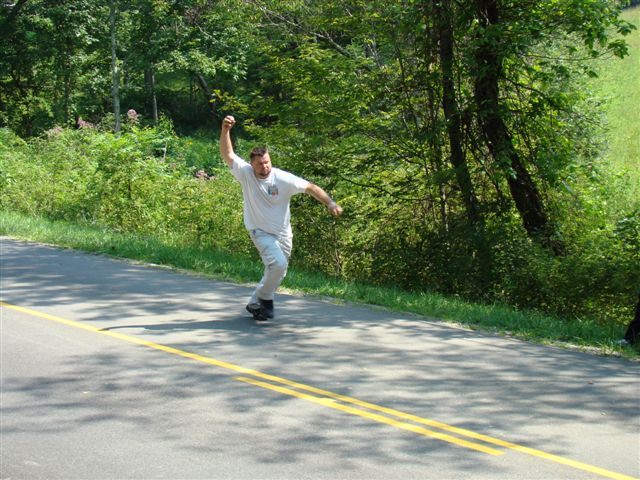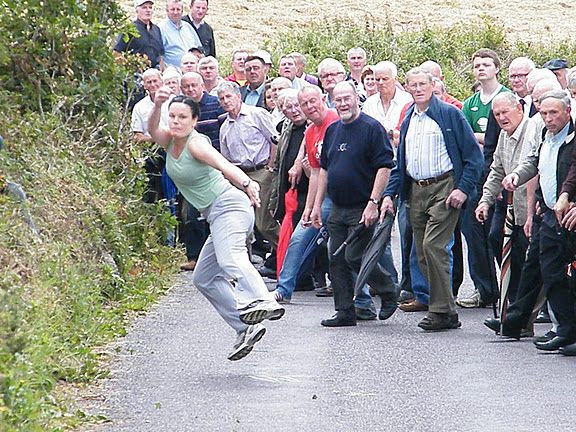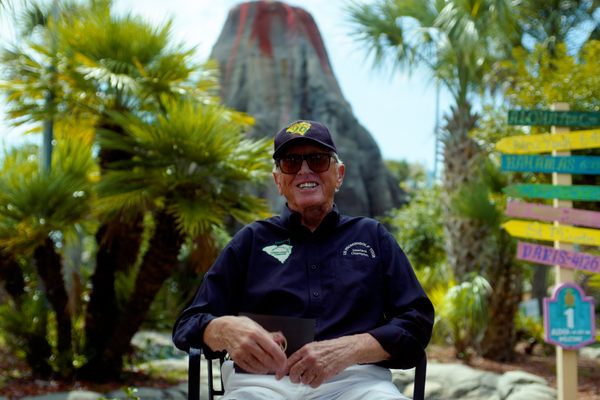Where Bowling Meets Golf on a Country Road in West Virginia
 An Irish Road Bowler in action. (Photo: Courtesy of West Virginia Road Bowling Association)
An Irish Road Bowler in action. (Photo: Courtesy of West Virginia Road Bowling Association)
On a winding country road in Ireland, West Virginia, a heated competition is taking place. Two rivals, standing in the middle of the road, take turns sprinting and hurling a custom-made iron ball down a hilly, bucolic stretch of lane. Cheerful spectators stand in the shoulder and applaud.
A good throw of the one-and-a-half pound iron ball, which is similar in size to a tennis ball, can roll for over 200 yards. A bad throw ends up in the ditch, or gets caught in the dense Appalachian undergrowth, where the competitor must brave itchy plants and stinging insects to retrieve it.
Welcome to the world of Irish Road Bowling.
“It’s really two sports in one,” says David Powell, the founder of the West Virginia Irish Road Bowling Association. ”It combines the intricacies of golf with the athleticism of bowling.”
A long-held tradition in the Irish counties of Cork and Armagh, bowling on the road has been happening since at least the late 17th century, according to Powell. But the pastime didn’t land in West Virginia until the mid-1990s.
“It was just three or four of us who started doing it in 1995,” Powell says. “We did it to add an event to a little St. Patrick’s Day festival they held in the town of Ireland, West Virginia.”
For a few years, Powell and his friends only played once a year. They were good, but not great by any means. “We didn’t know what the hell we were doing, but it was a ton of fun,” he says. “Once we hooked up with some real players in Boston, they taught us the serious game.”
Since then, the West Virginia Irish Road Bowling Association has organized an annual circuit of 19 events throughout the state, with the season running between March and November. The dedicated players make it out to each event, and there’s even a national championship where the best clubs from Boston and New York come out to play.
The object of the game is simple: in order to win, you need to get your ball to the goal in as few tosses as possible. The best players, at least in West Virginia, can finish the course in 14 or 15 tosses. The courses are about a mile long, and are designed around the twists, turns, and differing grades of the road. Unlike ten-pin bowing, though, there are no lanes, no TV monitors to keep score, and definitely no bumpers to pad mistakes. One small error can mean the difference between winning and losing.
 A champion Irish Road Bowler goes airborne on the release in West Virginia. (Photo: Courtesy of West Virginia Road Bowling Association)
A champion Irish Road Bowler goes airborne on the release in West Virginia. (Photo: Courtesy of West Virginia Road Bowling Association)
This is where the golf aspect comes into consideration. While some straighter courses favor brute strength, the Irish Road Bowling tournaments are usually won and lost through a combination of accuracy, timing, and consistency. Twisty roads, with sharp curves and elevation changes, add an element of difficulty. “Every player is trying to maximize speed, while maintaining that accuracy,” says Powell. “And the best players are deadly accurate. It’s awesome.”
If you’d like to see the top road bowlers competing in person, the 2015 North American Regional Finals are being held on August 7-9 in Buckhannon, West Virginia. Unlike other sports, though, you can get up close to the action, by walking on the the grassy shoulder of the road as the bowlers duke it out in the middle of the course.
Standing at the finish line comes close to the feeling of being a Yankees fan during the final stages of a nail-biting game, according to Powell. “It’s kind of like there’s two outs, and it’s the bottom of the ninth,” he says. “The whole thing comes down to the last toss.”
 An Irish Road Bowling ball, made out of iron, and weighing just over a pound. (Photo: Courtesy of West Virginia Irish Road Bowling Association)
An Irish Road Bowling ball, made out of iron, and weighing just over a pound. (Photo: Courtesy of West Virginia Irish Road Bowling Association)










Follow us on Twitter to get the latest on the world's hidden wonders.
Like us on Facebook to get the latest on the world's hidden wonders.
Follow us on Twitter Like us on Facebook